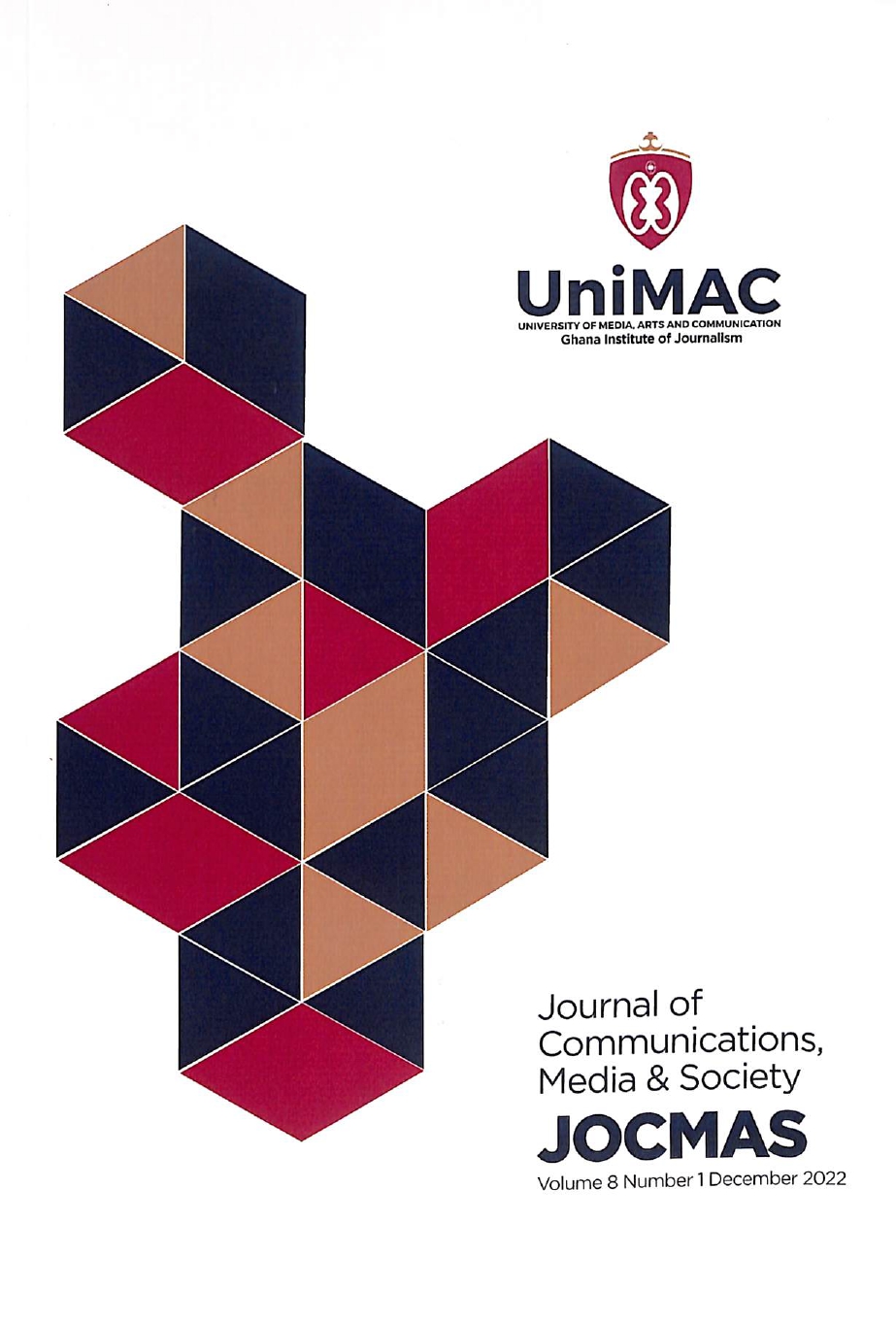Exploring MIL Opportunities in Senior High Schools in Ghana: Perspectives from Teachers and Students
DOI:
https://doi.org/10.63772/jocmas.v8n1.4Keywords:
MIL Opportunities, Senior High Schools, Ghana, Teachers, StudentsAbstract
As young people increasingly conduct both academic and personal activities online, curriculum and extra-curriculum content in the school system are evolving to address their media and information literacy (MIL) needs to position them to become responsible creators and consumers of online content. While this trend is common to the economically advanced world, the same cannot always be said for less-endowed countries. The aim of this study is to explore opportunities available in the senior high school system in Ghana for MIL content infusion. Using in-depth interviews with a purposive sample of supply (school heads, teachers and librarians) and demand side elements (students), the study attempts proposals for interventions in schools and extends the growing MIL scholarship with practical guides for increasing the MIL skills of young people in developing countries.
Downloads
Usage Statistics
- Abstract Views: 151
- PDF Downloads: 49
References
Adjin-Tettey, T. D. (2022). Combating fake news, disinformation, and misinformation: Experimental evidence for media literacy education. Cogent Arts & Humanities, 9(1), 1–17. https://doi.org/10.1080/23311983.2022.2037229 DOI: https://doi.org/10.1080/23311983.2022.2037229
Bucher, K. T. (2000). The importance of information literacy skills in the middle school curriculum: The clearing house. The Clearing House: A Journal of Educational Strategies, Issues and Ideas, 73(4), 217–220. https://doi.org/10.1080/00098650009600955 DOI: https://doi.org/10.1080/00098650009600955
Chen, D. T., Lin, T. B., Li, J. Y., & Lee, L. (2018). Establishing the norm of new media literacy of Singaporean students: Implications to policy and pedagogy. Computers & Education, 124, 1–13. https://doi.org/10.1016/j.compedu.2018.04.010 DOI: https://doi.org/10.1016/j.compedu.2018.04.010
Creswell, J. W. (2014). Research design: Qualitative and mixed methods approaches. Sage Publications.
Gildersleeves, L. (2012). Do school libraries make a difference?: Some considerations on investigating school library impact in the United Kingdom. Library Management, 33(6), 403–413. https://doi.org/10.1108/01435121211266212 DOI: https://doi.org/10.1108/01435121211266212
Harwell, M. R. (2014). Research design in qualitative/quantitative/mixed methods. In C. F. Conrad & R. C. Serlin (Eds.), The SAGE handbook for research in education: Pursuing ideas as the keystone of exemplary inquiry (pp. 147–164). Sage Publications. https://doi.org/10.4135/9781483351377 DOI: https://doi.org/10.4135/9781483351377.n11
Idiodi, E. A. (2005). Approaches to information literacy acquisition in Nigeria. Library Review, 54(4), 223–230. https://doi.org/10.1108/00242530510593416 DOI: https://doi.org/10.1108/00242530510593416
Kothari, C. (2004). Research methodology: Methods and techniques (2nd ed.). New Delhi: New Age International Publishers.
Ku, K. Y. L., Kong, Q., Song, Y., Deng, L., Kang, Y., & Hu, A. (2019). What predicts adolescents’ critical thinking about real-life news? The roles of social media news consumption and news media literacy. Thinking Skills and Creativity, 33, 100570. https://doi.org/10.1016/j.tsc.2019.05.004 DOI: https://doi.org/10.1016/j.tsc.2019.05.004
Kumar, R. (2011). Research methodology: A step-by-step guide for beginners (3rd ed.). Sage Publications.
Kvale, S. (2011). Introduction to interview research. In Doing interviews (pp. 2–10). Sage Publications Ltd. https://doi.org/10.4135/9781849208963 DOI: https://doi.org/10.4135/9781849208963
Lin, T. B., Mokhtar, I. A., & Wang, L. Y. (2015). The construct of media and information literacy in Singapore education system: Global trends and local policies. Asia Pacific Journal of Education, 35(4), 423–437. https://doi.org/10.1080/02188791.2013.860012 DOI: https://doi.org/10.1080/02188791.2013.860012
List, A., Brante, E. W., & Klee, H. L. (2020). A framework of pre-service teachers’ conceptions about digital literacy: Comparing the United States and Sweden. Computers & Education, 148, 103788. https://doi.org/10.1016/j.compedu.2019.103788 DOI: https://doi.org/10.1016/j.compedu.2019.103788
McDougall, J., & Sefton-Green, J. (2014). Media and information literacy policies in the UK (ANR TRANSLIT and COST “Transforming Audiences/Transforming Societies”). 1–40.
Mingoia, J., Hutchinson, A. D., Gleaves, D. H., & Wilson, C. (2019). The impact of a social media literacy intervention on positive attitudes to tanning: A pilot study. Computers in Human Behavior, 90, 188–195. https://doi.org/10.1016/j.chb.2018.09.004 DOI: https://doi.org/10.1016/j.chb.2018.09.004
Ministry of Education. (2018). National pre-tertiary education curriculum framework. https://nacca.gov.gh/wp-content/uploads/2019/04/National-Pre-tertiary-EducationCurriculum-Framework-final.pdf
Moeller, S., Joseph, A., Lau, J., & Carbo, T. (2011). Towards media and information literacy indicators: Background document of the expert meeting 4–6 November 2010, Bangkok, Thailand. UNESCO.
Polizzi, G. (2020). Digital literacy and the national curriculum for England: Learning from how the experts engage with and evaluate online content. Computers & Education, 152, 103859. https://doi.org/10.1016/j.compedu.2020.103859 DOI: https://doi.org/10.1016/j.compedu.2020.103859
Reineck, D., & Lublinski, J. (2015). Media and information literacy: A human rights-based approach in developing countries [Discussion paper].
Saleh, I. (2012). Media and information literacy in South Africa: Goals and tools. Comunicar, 20(39), 35–43. https://doi.org/10.3916/C39-2012-02-03 DOI: https://doi.org/10.3916/C39-2012-02-03
Tamplin, N. C., McLean, S. A., & Paxton, S. J. (2018). Social media literacy protects against the negative impact of exposure to appearance ideal social media images in young adult women but not men. Body Image, 26, 29–37. https://doi.org/10.1016/j.bodyim.2018.05.003 DOI: https://doi.org/10.1016/j.bodyim.2018.05.003
Tettey, W. J. (2013). Media and information literacy, informed citizenship and democratic development in Africa: A handbook for media/information producers and users.
Wilson, C. (2019). Media and information literacy: Challenges and opportunities for the world of education. The Canadian Commission for UNESCO’s IdeaLab.
Xie, X., Gai, X., & Zhou, Y. (2019). A meta-analysis of media literacy interventions for deviant behaviors. Computers & Education, 139, 146–156. https://doi.org/10.1016/j.compedu.2019.05.008 DOI: https://doi.org/10.1016/j.compedu.2019.05.008
Zou’bi, R. Al. (2021). The impact of media and information literacy on acquiring the critical thinking skill by the educational faculty’s students. Thinking Skills and Creativity, 39, 100782. https://doi.org/10.1016/j.tsc.2020.100782 DOI: https://doi.org/10.1016/j.tsc.2020.100782
Downloads
Published
Issue
Section
License
Copyright (c) 2025 Journal of Communications, Media And Society (JOCMAS)

This work is licensed under a Creative Commons Attribution-NonCommercial 4.0 International License.








